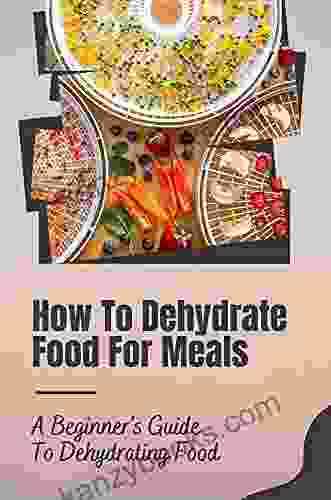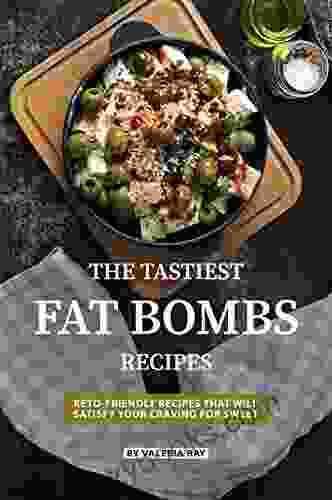The Ultimate Beginner's Guide to Dehydrating Food

Dehydrating food is a great way to preserve your food and extend its shelf life. It's also a great way to save money and reduce food waste.
5 out of 5
| Language | : | English |
| File size | : | 16086 KB |
| Text-to-Speech | : | Enabled |
| Screen Reader | : | Supported |
| Enhanced typesetting | : | Enabled |
| Print length | : | 326 pages |
| Lending | : | Enabled |
In this guide, we'll teach you everything you need to know about dehydrating food, including:
- The benefits of dehydrating food
- The different types of food that can be dehydrated
- The equipment you need to get started
- The steps involved in dehydrating food
- How to store dehydrated food
The Benefits of Dehydrating Food
There are many benefits to dehydrating food, including:
- Extended shelf life: Dehydrated food can be stored for months or even years without spoiling.
- Reduced food waste: Dehydrating food is a great way to use up leftover produce and prevent it from going to waste.
- Saved money: Dehydrating food can save you money by reducing the amount of food you buy and waste.
- Convenience: Dehydrated food is lightweight and easy to transport, making it a great option for camping, hiking, and other outdoor activities.
- Nutrition: Dehydrated food retains most of its nutrients, making it a healthy alternative to processed snacks.
The Different Types of Food That Can Be Dehydrated
Almost any type of food can be dehydrated, including:
- Fruits: Apples, bananas, berries, peaches, pears, etc.
- Vegetables: Carrots, celery, corn, green beans, onions, peppers, etc.
- Meats: Beef, chicken, fish, pork, etc.
- Herbs and spices
- Dairy products: Cheese, milk powder, yogurt
The Equipment You Need to Get Started
The basic equipment you need to get started with dehydrating food includes:
- A food dehydrator: This is the most important piece of equipment, as it will circulate warm air around your food to remove the moisture.
- Trays: These are the trays that you will place your food on to dehydrate.
- A sharp knife: You will need this to cut your food into thin slices.
- A cutting board
- A measuring cups and spoons
The Steps Involved in Dehydrating Food
The steps involved in dehydrating food are simple:
- Prepare your food: This involves washing, peeling, and slicing your food into thin pieces.
- Arrange your food on the trays: Make sure that the pieces of food are not touching each other.
- Set the temperature and time: The temperature and time will vary depending on the type of food you are dehydrating.
- Start the dehydration process: Once you have set the temperature and time, start the dehydration process.
- Check your food periodically: You will need to check your food periodically to make sure that it is drying evenly.
- Remove the food from the dehydrator: Once your food is dry, remove it from the dehydrator and let it cool completely.
How to Store Dehydrated Food
Dehydrated food should be stored in an airtight container in a cool, dark place. This will help to extend its shelf life.
Here are some additional tips for storing dehydrated food:
- Use vacuum-sealed bags to store dehydrated food for long-term storage.
- Store dehydrated food in a cool, dry place away from direct sunlight.
- Check your dehydrated food regularly for spoilage.
Dehydrating food is a great way to preserve your food and extend its shelf life. It's also a great way to save money and reduce food waste. With the right equipment and knowledge, you can easily dehydrate your own food at home.
5 out of 5
| Language | : | English |
| File size | : | 16086 KB |
| Text-to-Speech | : | Enabled |
| Screen Reader | : | Supported |
| Enhanced typesetting | : | Enabled |
| Print length | : | 326 pages |
| Lending | : | Enabled |
Do you want to contribute by writing guest posts on this blog?
Please contact us and send us a resume of previous articles that you have written.
 Book
Book Novel
Novel Page
Page Chapter
Chapter Text
Text Story
Story Genre
Genre Reader
Reader Library
Library Paperback
Paperback E-book
E-book Magazine
Magazine Newspaper
Newspaper Paragraph
Paragraph Sentence
Sentence Bookmark
Bookmark Shelf
Shelf Glossary
Glossary Bibliography
Bibliography Foreword
Foreword Preface
Preface Synopsis
Synopsis Annotation
Annotation Footnote
Footnote Manuscript
Manuscript Scroll
Scroll Codex
Codex Tome
Tome Bestseller
Bestseller Classics
Classics Library card
Library card Narrative
Narrative Biography
Biography Autobiography
Autobiography Memoir
Memoir Reference
Reference Encyclopedia
Encyclopedia William K Lawrence
William K Lawrence Letizia Guglielmo
Letizia Guglielmo Steven Manners
Steven Manners The Merry Way Witch
The Merry Way Witch Troye Evers
Troye Evers Mark Bittman
Mark Bittman Jennifer Donnelly
Jennifer Donnelly Simona Simmons
Simona Simmons Tony Giordano
Tony Giordano Leslie Taylor
Leslie Taylor Sophie Allison
Sophie Allison Suren Shrestha
Suren Shrestha Lynelle Woolley
Lynelle Woolley Woodrow C Monte
Woodrow C Monte Saray Stancic
Saray Stancic Vicki Krohn Amorose
Vicki Krohn Amorose Lynette Eason
Lynette Eason Silver Bullet
Silver Bullet Yury Verlinsky
Yury Verlinsky Stephen Blake
Stephen Blake
Light bulbAdvertise smarter! Our strategic ad space ensures maximum exposure. Reserve your spot today!
 Isaac BellFollow ·6.2k
Isaac BellFollow ·6.2k Branden SimmonsFollow ·2.8k
Branden SimmonsFollow ·2.8k Jack ButlerFollow ·16k
Jack ButlerFollow ·16k Jerome BlairFollow ·14k
Jerome BlairFollow ·14k Israel BellFollow ·12.3k
Israel BellFollow ·12.3k David Foster WallaceFollow ·17.2k
David Foster WallaceFollow ·17.2k Henry HayesFollow ·19.1k
Henry HayesFollow ·19.1k Jonathan HayesFollow ·7.5k
Jonathan HayesFollow ·7.5k

 Virginia Woolf
Virginia WoolfGetting High Fat Diet Easily Using Keto Fat Bomb Cookbook
Unveiling the Power of Fat...

 Milan Kundera
Milan KunderaAre You Cryin' Brian? Find the Inspiration and Humor in...
Life can be full of...

 Edmund Hayes
Edmund HayesUnlock Your Vitality: The 15-Day Natural Energy Boost...
Are You Ready to...

 Gavin Mitchell
Gavin MitchellMultiple Sclerosis Life Expectancy: Unveiling the Impact...
Multiple Sclerosis (MS) is a...

 Gabriel Garcia Marquez
Gabriel Garcia MarquezGet The Thighs That Can Crack Man Head Like Walnut
Are you tired of weak, flabby...
5 out of 5
| Language | : | English |
| File size | : | 16086 KB |
| Text-to-Speech | : | Enabled |
| Screen Reader | : | Supported |
| Enhanced typesetting | : | Enabled |
| Print length | : | 326 pages |
| Lending | : | Enabled |













